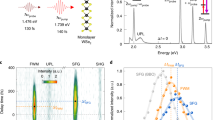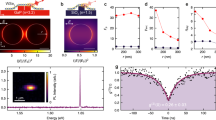Abstract
We study theoretically the nonlinear optical response of a monolayer of regularly arranged three-level identical quantum emitters with a doublet in the excited state to the action of a monochromatic electromagnetic field quasi-resonant to optical transitions in the emitter. The total retarded dipole–dipole interaction of the emitters is accounted for in the mean-field approximation. This interaction plays the role of a positive feedback, which (in combination with the immanent nonlinearity of emitters themselves) leads to multistability of the monolayer response. The stability of different response branches is analyzed using the Lyapunov exponents method. It is found that the instability type depends on the doublet splitting and changes from self-oscillations to chaos upon increasing the splitting. Another important property of the monolayer is its high (almost 100%) reflectance in a certain frequency range; i.e., within this range, the monolayer operates as a perfect nanometer mirror; moreover, reflection can be switched to transmission changing slightly the incident field amplitude (bistability). The possibility of application of the above mentioned monolayer optical properties in nanophotonics is discussed.







Similar content being viewed by others
REFERENCES
N. I. Zheludev, Science (Washington, DC, U. S.) 328, 582 (2010).
C. M. Soukoulis and M. Wegener, Science (Washington, DC, U. S.) 330, 1633 (2010).
Y. Liu and X. Zhang, Chem. Soc. Rev. 40, 2494 (2011).
W. H. Evers, B. Goris, S. Bals, M. Casavola, J. de Graaf, R. van Roij, M. Dijkstra, and D. Vanmaekelbergh, Nano Lett. 13, 2317 (2013).
M. P. Boneschanscher, W. H. Evers, J. J. Geuchies, T. Altantzis, B. Goris, F. T. Rabouw, S. A. P. van Rossum, H. S. J. van der Zant, L. D. A. Siebbeles, G. van Tendeloo, I. Swart, J. Hilhorst, A. V. Petukhov, S. Bals, and D. Vanmaekelbergh, Science (Washington, DC, U. S.) 344, 1377 (2014).
A. V. Baranov, E. V. Ushakova, V. V. Golubkov, A. P. Litvin, P. S. Parfenov, A. V. Fedorov, and K. Berwick, Langmuir 31, 506 (2015).
W. Liu, X. Luo, Y. Bao, Y. P. Liu, G.-H. Ning, I. Abdelwahab, L. Li, C. T. Nai, Z. G. Hu, D. Zhao, B. Liu, S. Y. Quek, and K. P. Loh, Nat. Chem. 9, 563 (2017).
A. S. Baimuratov, I. D. Rukhlenko, V. K. Turkov, A. V. Baranov, and A. V. Fedorov, Sci. Rep. 3, 1727 (2013).
A. S. Baimuratov, I. D. Rukhlenko, and A. V. Fedorov, Opt. Lett. 38, 2259 (2013).
A. S. Baimuratov, A. I. Shlykov, W. Zhu, M. Yu. Leonov, A. V. Baranov, A. V. Fedorov, and I. D. Rukhlenko, Opt. Lett. 42, 2223 (2017).
I. A. Vovk, N. V. Tepliakov, A. S. Baimuratov, M. Yu. Leonov, A. V. Baranov, A. V. Fedorov, and I. D. Rukhlenko, Phys. Chem. Phys. 20, 25023 (2018).
J. F. Nossa and A. S. Camacho, Microelectron. J. 38, 1251 (2008).
A. S. Baimuratov, Y. K. Gun’ko, A. V. Baranov, A. V. Fedorov, and I. D. Rukhlenko, Sci. Rep. 6, 23321 (2016).
R. Malikov, I. Ryzhov, and V. Malyshev, Eur. Phys. J. Web Conf. 161, 02014 (2017).
V. A. Malyshev, P. Á. Zapatero, A. V. Malyshev, R. F. Malikov, and I. V. Ryzhov, J. Phys.: Conf. Ser. 1220, 012006 (2019).
I. V. Ryzhov, R. F. Malikov, A. V. Malyshev, and V. A. Malyshev, Phys. Rev. A 100, 033820 (2019).
I. Ryzhov, R. Malikov, A. Malyshev, and V. Malyshev, Eur. Phys. J. Web Conf. 220, 02012 (2019).
Al. L. Efros, M. Rosen, M. Kuno, M. Nirmal, D. J. Norris, and M. Bawendi, Phys. Rev. B 54, 4843 (1996).
D. Bayramdurdiyev, R. Malikov, I. Ryzhov, and V. Malyshev, Eur. Phys. J. Web Conf. 220, 03004 (2019).
R. A. Vlasov, A. M. Demeza, and M. G. Gladush, J. Appl. Spectrosc. 80, 698 (2013).
R. A. Vlasov, A. M. Lemeza, and M. G. Gladush, Laser Phys. Lett. 10, 045401 (2013).
G. Lindblad, Comm. Math. Phys. 48, 119 (1976).
K. Blum, Density Matrix: Theory and Applications (Springer, Berlin, 2012).
R. H. Dicke, Phys. Rev. 93, 99 (1954).
R. F. Malikov, E. D. Trifonov, and A. I. Zaitsev, Sov. Phys. JETP 49, 33 (1979).
M. G. Benedict, A. M. Ermolaev, V. A. Malyshev, I. V. Sokolov, and E. D. Trifonov, Super-Radiance: Multiatomic Coherent Emission (IOP, Bristol, 1996).
J.-P. Eckmann and D. Ruelle, Rev. Mod. Phys. 57, 617 (1985).
A. Katok and B. Hasselblatt, Introduction to the Modern Theory of Dynamical Systems (Cambridge Univ. Press, Cambridge, 1997).
A. A. Andronov, A. A. Vitt, and S. E. Khaikin, Theory of Oscillators (Pergamon, New York, 1966).
J. Guckenheimer and P. Holmes, Nonlinear Oscillations, Dynamical Systems and Bifurcations of Vector Fields (Springer, Berlin, 1986).
V. S. Afrajmovich, Yu. S. Il’yashenko, and L. P. Shil’nikov, Dynamical Systems V: Bifurcation Theory and Catastrophe Theory, Ed. by V. I. Arnol’d (Springer, Berlin, 1994).
Y. Ben-Aryeh, C. M. Bowden, and J. C. Englund, Phys. Rev. A 34, 3917 (1086).
S. M. Zakharov and E. A. Manykin, Poverkhnost’, No. 2, 137 (1988).
A. M. Basharov, Sov. Phys. JETP 67, 1131 (1988).
M. G. Benedikt, A. I. Zaitsev, V. A. Malyshev, and E. D. Trifonov, Opt. Spectrosc. 68, 473 (1990).
M. G. Benedict, A. I. Zaitsev, V. A. Malyshev, and E. D. Trifonov, Phys. Rev. A 43, 3845 (1991).
A. N. Oraevsky, D. J. Jones, and D. K. Bandy, Opt. Commun. 111, 163 (1994).
V. A. Malyshev and E. Conejero Jarque, Opt. Experess 6, 227 (2000).
H. Glaeske, V. A. Malyshev, and K.-H. Feller, J. Chem. Phys. 113, 1170 (2000).
J. A. Klugkist, V. A. Malyshev, and J. Knoester, J. Chem. Phys. 127, 164705 (2007).
R. F. Malikov and V. A. Malyshev, Opt. Spectrosc. 122, 955 (2017).
R. F. Malikov and V. A. Malyshev, Eur. Phys. J. Web Conf. 161, 03005 (2017).
S. Stufler, P. Machnikowski, P. Ester, M. Bichler, V. M. Axt, T. Kuhn, and A. Zrenner, Phys. Rev. B 73, 125304 (2006).
T. Gao and Z. Chen, Phys. Lett. A 372, 394 (2008).
P. Back, S. Zeytinoglu, A. Ijaz, M. Kroner, and A. Imamoğlu, Phys. Rev. Lett. 120, 037401 (2018).
G. Scuri, Y. Zhou, A. A. High, D. S. Wild, C. Shu, K. de Greve, L. A. Jauregui, T. Taniguchi, K. Watanabe, P. Kim, M. D. Lukin, and H. Park, Phys. Rev. Lett. 120, 037402 (2018).
Author information
Authors and Affiliations
Corresponding authors
Additional information
Translated by N. Wadhwa
Appendices
Solution of the Steady-State Problem
The steady-state solutions to the problem considered here (\({{\dot {\rho }}_{{\alpha \beta }}}\) = 0, α, β = 1, 2, 3) can be found by solving the following system off nonlinear algebraic equations:
where we used the substitution
Further, we define two vectors,
The system of equations (22)–(26) can be written in the matrix form:
where the superscript T indicates the transposition, and the explicit form of the matrix \({{\mathcal{M}}_{{ij}}}\), i, j = 1, 2, …, 8 can easily be reconstructed from Eqs. (22)–(26). The formal solution to Eq. (28) reads
where the inverse matrix \({{\mathcal{M}}^{{ - 1}}}\) can be found in an explicit form. It should be emphasized that both \(\mathcal{M}\) and \({{\mathcal{M}}^{{ - 1}}}\) and, accordingly, the solution to Eq. (29) depend parametrically on Ω. Having determined the vector r, we can use it in (27) and obtain a closed equation for Ω . Knowing Ω , we can easily reconstruct all elements of the density matrix using Eq. (29) (see [16] for details). Thus, the steady-state problem is solved exactly.
Normal Modes of Dressed V-QE
As noted in Section 3.3, the optical transitions 1 ↔ 2 and 1 ↔ 3 in the dressed V-QE, first, acquire the frequency shifts and additional broadenings and, second, interact with each other due to the secondary field. We are interested in the normal modes of such a system in the linear case (|Ω0| ≪ 1, ρ11 ≈ 1). These modes can be found by solving the homogeneous problem (Ω0 = 0):
where we set Δ31 = 0 and Δ21 = –Δ32 (in zero external field) and introduced the notation
Further, let us seek the solution in the standard form ραβ = Rαβexp(κt). Equating the determinant of the resultant system of algebraic equations to zero, we obtain the following equation for the eigenfrequencies of normal modes:
We do not write down here the cumbersome general expression for the roots κ± of Eq. (32) and restrict our analysis to the case of μ = 1. Then
Further, we take into account the fact that under the conditions considered in this study, the value of ΔL is much larger than the values of remaining quantities (Δ32, Γ2, Γ3, and γR) so that one can use for κ± the expansion into the Taylor series in small parameters Δ32/ΔL, Γ2/ΔL, Γ3/ΔL, and γR/ΔL. Under these assumptions, the expressions for the roots κ± take the form
From here it follows that the bare frequencies – ΔL and ‒(ΔL + Δ32) (see Eqs. (30) and (31)), detuned from each other by ΔL, are radically renormalized due to the interaction: the frequencies of normal modes have values –Δ32/2 and –(2ΔL + Δ32/2) and differ from each other by 2ΔL. The relaxation constants of the normal modes are also modified considerably: the mode “+” now contains the double collective constant γR, while this constant is completely absent in the mode “–.”
Using the algebraic equations for the amplitudes R31 and R21, one can find the ratio R31/R21 in the modes “+” and “–.” Simple calculations show that
i.e., the amplitudes R31 and R21 in the mode “+” are added in phase (symmetric, or bright mode), while in the mode “–,” these amplitudes are added in antiphase (antisymmetric, or dark mode). This is precisely what determines the coupling (strong or weak) of these modes with the external field. The mode mixing depends linearly on the doublet splitting Δ32. This is confirmed in the linear regime of reflection (see Fig. 6).
Rights and permissions
About this article
Cite this article
Bairamdurdyev, D.Y., Malikov, R.F., Ryzhov, I.V. et al. Nonlinear Optical Dynamics and High Reflectance of a Monolayer of Three-Level Quantum Emitters with a Doublet in the Excited State. J. Exp. Theor. Phys. 131, 244–254 (2020). https://doi.org/10.1134/S1063776120060011
Received:
Revised:
Accepted:
Published:
Issue Date:
DOI: https://doi.org/10.1134/S1063776120060011




